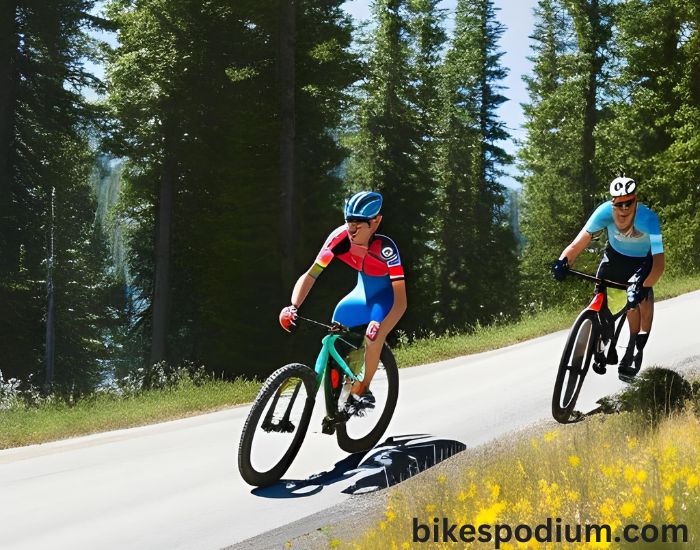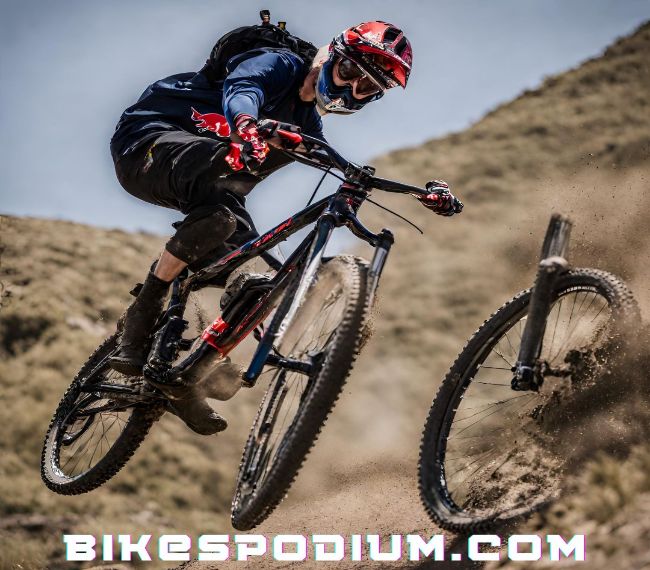
When it comes to choosing a bike for off-road adventures, two popular options that often come to mind are mountain bikes and gravel bikes.
Both types of bicycles are designed for specific terrains and offer unique advantages.
In this article, we will explore the key differences between mountain bikes and gravel bikes, helping you make an informed decision based on your riding preferences and needs.
Purpose and Terrain
Mountain Bike
Mountain bikes, as the name suggests, are primarily designed for off-road mountainous terrains.
These bikes are built to handle challenging and technical trails with various obstacles such as rocks, roots, steep descents, and tight turns.
They feature a sturdy frame, wide and knobby tires, and a suspension system to absorb shocks and enhance control.
Mountain bikes are perfect for adrenaline junkies who enjoy tackling rugged trails and exploring nature.
Some points to consider about mountain bikes:
- The sturdy frame of mountain bikes is made to withstand the rough and unpredictable terrains encountered on mountain trails.
- The wide and knobby tires provide maximum traction and control, allowing riders to confidently navigate through mud, loose rocks, and steep inclines.
- The suspension system, available in both hardtail and full suspension options, helps absorb shocks and impacts, providing a smoother ride on rough trails.
- Mountain bikes are ideal for riders who crave the thrill of off-road adventures and enjoy the challenge of technical descents and demanding climbs.
Gravel Bike
Gravel bikes, on the other hand, are designed to excel on a wide range of surfaces, including gravel, dirt roads, and tarmac.
These versatile bicycles combine features from road bikes and mountain bikes, allowing riders to comfortably explore both on and off-road terrains.
Gravel bikes typically have a lightweight frame, wider tires with a smoother tread pattern than mountain bikes, and a less aggressive riding position.
They are ideal for riders who enjoy long-distance rides, bikepacking, and exploring scenic routes.
Some points to consider about gravel bikes:
- Gravel bikes offer a balance between the speed and efficiency of road bikes and the stability and versatility of mountain bikes.
- The lightweight frame of gravel bikes allows for easier maneuverability and a more comfortable riding position, making them suitable for long-distance rides.
- The wider tires with a smoother tread pattern provide grip on gravel or dirt surfaces without compromising rolling efficiency on paved roads.
- Gravel bikes are perfect for riders who want to explore mixed terrains, go on bikepacking adventures, and enjoy the freedom of riding on both roads and off-road trails.
Frame and Geometry
Certainly, here’s the difference between mountain bikes and gravel bikes in a table format:
| Aspect | Mountain Bike | Gravel Bike |
|---|---|---|
| 1. Frame |
|
|
|
| |
|
| |
|
| |
| 2. Geometry |
|
|
|
| |
|
| |
|
|
This table summarizes the key differences between mountain bikes and gravel bikes in terms of their frame and geometry, highlighting the distinct characteristics of each type of bike.
Mountain Bike
Mountain bikes usually have a robust and durable frame with a more upright riding position.
The frame geometry is designed to provide stability and control on challenging terrains. They often feature a sloping top tube, a longer wheelbase, and a slacker head tube angle.
These characteristics ensure better stability at high speeds and during technical descents.
Additionally, mountain bikes have a suspension system, with either front suspension (hardtail) or both front and rear suspension (full suspension) options.
The suspension helps absorb shocks and impacts, providing a smoother ride on rough trails.
Some points to consider about mountain bike frame and geometry:
- The robust and durable frame of mountain bikes is built to withstand the rough and demanding nature of off-road trails.
- The more upright riding position offers an improved view of the trail, allowing riders to react quickly to obstacles and maintain control in challenging situations.
- The sloping top tube provides additional standover clearance, making it easier for riders to dismount the bike when necessary.
- The longer wheelbase and slacker head tube angle contribute to better stability at high speeds and during technical descents, enhancing the overall control and confidence of the rider on the trail.
Gravel Bike
Gravel bikes have a lightweight and versatile frame that offers a more relaxed and comfortable riding position compared to mountain bikes.
The frame geometry is designed to balance stability and efficiency on mixed terrain. Gravel bike frames often have a taller head tube, shorter top tube, and a longer wheelbase compared to road bikes.
This combination provides stability while maintaining maneuverability.
Although gravel bikes do not typically feature a full suspension like mountain bikes, they may have some form of suspension, such as a suspension seat post or fork, to improve comfort on rough surfaces.
Some points to consider about gravel bike frame and geometry:
- The lightweight frame of gravel bikes allows for easier maneuverability and a more comfortable riding position, making them suitable for long-distance rides.
- The taller head tube and shorter top tube provide a more upright riding position, reducing strain on the back and neck during long hours in the saddle.
- The longer wheelbase contributes to stability, especially when riding on uneven terrain, while maintaining maneuverability for quick direction changes.
- Some gravel bikes may incorporate suspension elements like a suspension seat post or fork to provide additional comfort on rough surfaces, enhancing the overall ride quality.
Tires and Wheels
Mountain Bike
Mountain bikes come equipped with wider and knobby tires, designed to provide maximum traction and control on rough terrains.
These tires have aggressive tread patterns, allowing riders to confidently navigate through mud, loose rocks, and steep inclines.
Mountain bike wheels are usually sturdier and built to withstand the demands of technical trails. They are available in various sizes, with 27.5 and 29 being the most common options.
The larger wheel size (29) offers better rollover capability, while the smaller size (27.5) provides quicker acceleration and maneuverability.
Some points to consider about mountain bike tires and wheels:
- The wider and knobby tires of mountain bikes offer excellent grip and traction on unpredictable terrains, ensuring control and stability.
- The aggressive tread patterns are specifically designed to provide grip on loose surfaces like mud, rocks, and gravel, allowing riders to confidently tackle challenging trails.
- Mountain bike wheels are built to withstand the demands of technical trails, providing durability and reliability in rough conditions.
- The choice between 27.5 and 29-inch wheel sizes depends on personal preference and riding style. The larger 29-inch wheels offer better rollover capability, allowing riders to maintain momentum over obstacles, while the smaller 27.5-inch wheels provide quicker acceleration and improved maneuverability in tight spaces.
Gravel Bike
Gravel bikes feature wider tires than road bikes but narrower and smoother tires than mountain bikes.
These tires strike a balance between rolling efficiency on paved roads and grip on gravel or dirt surfaces.
Gravel bike tires often have a tread pattern that offers some traction without compromising speed or comfort.
The wheels on gravel bikes are usually lighter and more aerodynamic than those on mountain bikes, allowing riders to maintain a good pace on mixed terrains.
The most common wheel size for gravel bikes is 700c.
Some points to consider about gravel bike tires and wheels:
- The wider tires of gravel bikes provide enhanced stability and grip on loose surfaces while still maintaining good rolling efficiency on paved roads.
- The smoother tread pattern on gravel bike tires ensures a comfortable and efficient ride, allowing riders to cover long distances without compromising speed.
- Gravel bike wheels are designed to be lighter and more aerodynamic than mountain bike wheels, enabling riders to maintain a good pace on both road and off-road surfaces.
- The 700c wheel size is the most common choice for gravel bikes, offering a balance between rollover capability and agility, suitable for a variety of terrains and riding styles.
Gearing and Components
Mountain Bike
Mountain bikes typically have a wide range of gears to conquer steep climbs and navigate technical descents.
They often come with a triple-chainring crankset or a double-chainring crankset paired with a wide-range cassette.
This combination provides a broad gear range that allows riders to tackle any terrain, whether it’s a challenging ascent or a fast downhill section.
Mountain bikes also feature powerful hydraulic disc brakes that offer excellent stopping power, even in wet and muddy conditions.
Additionally, they may include other components like dropper seatposts for improved maneuverability on steep descents.
Some points to consider about mountain bike gearing and components:
- The wide range of gears on mountain bikes allows riders to tackle a variety of terrains, from steep uphill climbs to fast downhill descents.
- The triple-chainring or double-chainring crankset, combined with a wide-range cassette, provides a broad gear range that caters to different riding conditions and preferences.
- Hydraulic disc brakes on mountain bikes deliver powerful and consistent stopping power, ensuring reliable braking performance even in challenging conditions.
- Additional components like dropper seatposts can be found on mountain bikes, allowing riders to adjust their seat height on the fly for improved maneuverability and control during steep descents.
Gravel Bike
Gravel bikes usually feature a compact or double-chainring crankset paired with a wide-range cassette, offering a suitable gear range for mixed terrain riding.
While not as extensive as mountain bike gearing, gravel bike gearing provides enough options for comfortable climbing and efficient pedaling on various surfaces.
Gravel bikes are often equipped with mechanical or hydraulic disc brakes, ensuring reliable stopping power in different conditions.
Some gravel bikes may also include additional features like fender mounts, rack mounts, or tubeless-ready tires, enhancing their versatility for commuting or bikepacking purposes.
Some points to consider about gravel bike gearing and components:
- The compact or double-chainring crankset combined with a wide-range cassette on gravel bikes provides a suitable gear range for mixed terrain riding, offering comfortable climbing and efficient pedaling.
- Gravel bikes may not have as wide a range of gears as mountain bikes, but they offer enough options to tackle various surfaces and gradients encountered on gravel or dirt roads.
- Mechanical or hydraulic disc brakes on gravel bikes ensure reliable and consistent stopping power, allowing riders to maintain control in different weather and terrain conditions.
- Some gravel bikes may include additional features like fender mounts, rack mounts, or tubeless-ready tires, enhancing their versatility for commuting, bikepacking, or carrying additional gear during adventures.
Conclusion
In summary, mountain bikes and gravel bikes serve different purposes and excel in specific terrains.
Mountain bikes are designed for rugged off-road trails, offering superior control and suspension for adrenaline-fueled adventures.
On the other hand, gravel bikes are versatile machines, suitable for both on and off-road riding, providing comfort and efficiency for long-distance exploration.
Consider your riding preferences, the type of terrain you plan to tackle, and the features that matter most to you when choosing between a mountain bike and a gravel bike. Happy cycling!
FAQ
1. What is the main difference between a mountain bike and a gravel bike?
The main difference between a mountain bike and a gravel bike is their purpose and terrain. Mountain bikes are designed for off-road mountainous terrains with challenging obstacles, while gravel bikes excel on a wide range of surfaces including gravel, dirt roads, and tarmac.
2. What are the key features of a mountain bike?
Mountain bikes have a sturdy frame, wide and knobby tires, and a suspension system. The frame is built to withstand rough terrains, the tires provide maximum traction and control, and the suspension system absorbs shocks and impacts for a smoother ride on rough trails.
3. What are the key features of a gravel bike?
Gravel bikes have a lightweight frame, wider tires with a smoother tread pattern than mountain bikes, and a more relaxed riding position. The frame allows for easier maneuverability, the tires strike a balance between rolling efficiency and grip, and the riding position is comfortable for long-distance rides.
4. What are the differences in tires and wheels between mountain bikes and gravel bikes?
Mountain bikes have wider and knobby tires for maximum traction on rough terrains, while gravel bikes have wider tires than road bikes but narrower and smoother tires than mountain bikes. Mountain bike wheels are sturdier, while gravel bike wheels are lighter and more aerodynamic.



